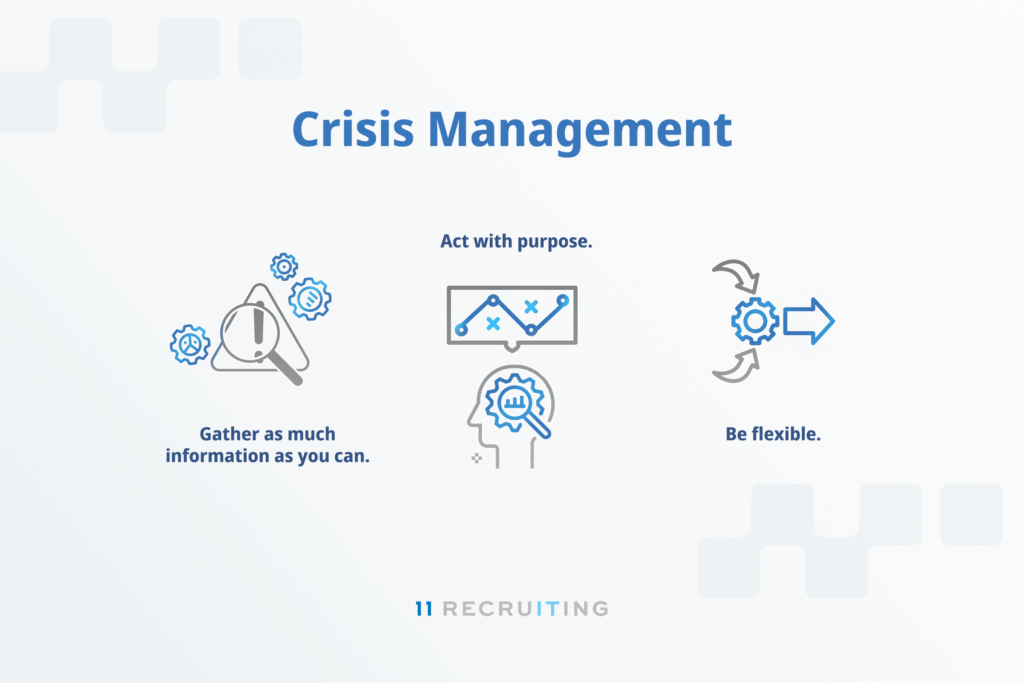
Management of anything is not an easy task. Whether you are managing a business or a group of people or children, there are certain things that you need to look out for when things start to get heated.
Professional crisis management is all about assessing a situation and making sure to put an end to any issue or problem. When different people with varying agendas come into contact, there is bound to be some conflict. While conflict is completely natural among people, not being able to foresee and de-escalate the conflict from becoming a crisis is a lapse in leadership.
What is Professional Crisis Management?
Professional Crisis Management, in the context of business, is the ability of the business to maintain operations and manage itself during a crisis. Management is hard enough when the threats are well known. The real challenge begins when an unexpected crisis comes along and the whole situation requires all hands on deck.
Training staff and making them accustomed to problem solving at work ensures that they are not taken aback by any situation. The less time it takes the organization to get a bearing of the crisis and the situation at large, the quicker it can formulate a plan of action.
Why is Crisis Management Important?
In today’s business climate, crisis management is essential to staying ahead of the competition and keeping your team systemically oriented to prioritization. Leaders within the organization or even at a personal level need to ensure that they are aware of their surroundings and ready to produce solutions.

A well developed crisis management plan has a couple of things that are well thought through.
- Roles are clearly defined.
- Effective communication is maintained.
- The crisis is immediately well documented.
- Effective actions are taken to resolve the crisis.
While this might have been something that only larger enterprises might have been concerned with in the past, smaller entities need to catch up. The world can flip upside down in a matter of months (read: pandemic) so being able to deal with unexpected incidents matters a lot.
Top employees know how to fix problems before they even arise. Hire a top employee today
Frequently Asked Questions
What is the purpose of crisis management?
Crisis management serves a singular purpose to prepare managers and other team members to deal with challenging situations before they happen. Having well throughout plans and standard operating procedures help reduce the time it takes to come up with a solution and allows teams to hit the ground running.
In more recent times, the increasing number of cyber attacks and threats can lead to a tech crisis which in itself is a significant challenge. Not only will you need to manage people, but you will also need to coordinate between different technical teams and be able to make the most out of the situation at hand to facilitate customers.
What is PCM in ABA?
Professional Crisis Management (PCM) is a comprehensive and widely accepted system for preventing and resolving harmful behavior in the context of Applied Behavior Analysis (ABA)
It takes a proactive approach in preventing conflict which makes it unique from other management systems. The main focus of this in ABA is to prevent a issues and problems before it happens and to de-escalate the situation.
How to Improve Your Crisis Management Skills?
Learning how to solve complex and time constrained problems is not easy by any standards. It takes time, effort and proper training to make sure that the individual being trained is able to handle the situation under pressure. Here are some ways to improve your crisis management:

Gather as much information as you can.
Knowledge is power and when there is a crisis at hand, having as much clarity about the situation is going to help you bring forth a solution. Ideally, you should have multiple people at the scene if this is something that concerns the business as a whole, but even if you’re the only one present, investing some time in gathering information is wise.
A crisis management team consists of members from different departments. this way gathering information becomes faster and easier since the members are accountable for their respective department.
Act with purpose.
Once you have a reasonably sound understanding about the crisis and most of the factors involved, you will be pressured to act and make decisions.
It is important that you do not compromise on the quality of your decisions in exchange for a supposed quick fix. Act with purpose and make incremental decisions if you have to diffuse the situation.
Be flexible.
Learning how to make yourself flexible in trying circumstances is crucial to ensuring that you are not seized when something doesn’t go according to plan. There are times that a crisis management plan does not go as smoothly as planned this is why you need to be flexible in making decisions.
You need to remember that you are dealing with immediate issues and that there may be some hiccups along the way. When you do encounter these hiccups, you should already have put in some thought on how to deal with them.
Even if you have not been able to do so, you should learn how to be flexible and think of something on the spot. Most successful plans involve a creative approach to different problems.
Develop the crisis management plan
Experiencing sudden problems at works teaches you that such things can happen. it’s important to review and revise your current plan to avoid facing the same problems over and over again. This will save your company time, money and effort in finding a remedy or band-aid solution.
The Chief Operations Officer often carries the burden of developing a plan of action for immediate problems. Along with department managers, The COO lays out protocols that prevent disasters. There are two ways to develop a good crisis management plan:
Proactive
- Start by plotting the your business operations. Identify the paths and channels your business needs to perform it’s operations. You may need the help of process managers or IT experts to better plot your operations.
- Divide your operations in levels with regard to how many people are involved with a certain process. In this step, you must fully understand how each level works.
- Identify main contacts for each level
- Theorize worst case scenarios on a company wide scope
- Create an action plan for each level with regard to each scenario . This will be your crisis management protocol
- Practice and evaluate these action plans and see how it works.
Reactive
This process is much simpler but more costly than the proactive method. It involves learning from experienced crises and plotting out the protocols for when a similar scenario comes up.
- Start by doing a post mortem analysis of the crisis
- Identify the outcomes
- Find the root cause
- calculate the costs
- Analyze the root cause and look for any deviation from the standard procedure. See if the cause is inevitable and recurring. if so, you might want to consider reformatting your business operations.
- If not, develop a protocol to limit the effects of the problem. Ask department managers and how their specific department is affected by the past issue.
- Create an action plan with regard to how their department was affected. This will be your crisis management protocol.
- Evaluate and revise the parts that don’t work.

